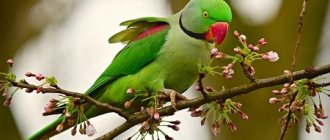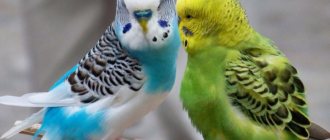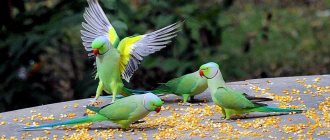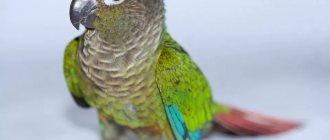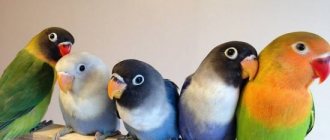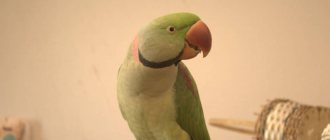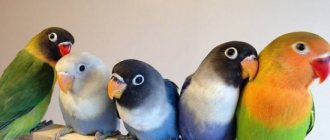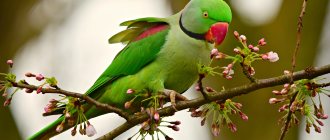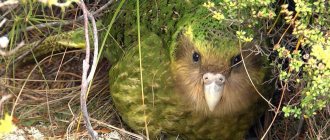- home
- Parrot
- FAQ
04/22/2019 Necklace parrots got their name due to the bright stripe in the form of a tie or necklace on the neck of males. These are cheerful and intelligent birds. Beginners and hobbyists appreciate them for their ease of care without unusual requests. The bird's popularity is enhanced by its intelligence and learning ability: the average vocabulary of a pet is 60 words, and especially smart ones can learn up to 250!
What sometimes stops you from buying an exotic pet is not knowing how much a necklace parrot costs. The expected price seems exorbitant, but these birds are not that expensive.
Description and features of the necklace parrot
The necklace parrot is a slender and neat bird of medium size: its size from beak to tail is 40 cm or a little more. Moreover, the tail occupies almost half of the total body length. There is no tuft on the head, the feathers lie evenly, as if combed. The body is covered with green, light green and yellowish feathers. Thanks to the grassy shade of the plumage, the bird is well camouflaged in the foliage of trees.
The main differences between Kramer's necklace parrot:
- The back of the head is bluish, the neck is decorated with a kind of collar - a stripe of black feathers. Below the back of the head, the dark tie turns into a pink “necklace”.
- Thin black stripes run from the eyes to the bridge of the nose, giving the bird a slightly frowning appearance. An orange stripe surrounds the eyes.
- The red beak has an unusual, interesting shape - rounded, its upper part is much larger than the lower.
- A separate line of features of the necklace parrot is the description of the tail - feathers grow in a cascade, in steps. The two longest ones are located in the center and are painted turquoise.
Note: only males over three years old can boast of colored “beads”; females and chicks do not have them.
In other representatives of ringed birds, the bulk of the feathers are colored in approximately the same range, the global difference is only in the shade of the “necklace”. Birds whose colors stand out from the general palette are bred through selective breeding: with white, blue and even variegated feathers.
How to teach to speak?
Parrots speak only if they live alone. Two individuals in the same house will communicate with each other; they do not need to learn to speak with a person. If you want to teach a bird to speak, do it at a young age.
An adult specimen is difficult to train:
- Repeat a certain word to the bird every day.
- Choose a simple first word.
- Don't give up, the results will appear over time, birds learn to speak at different speeds, just like people.
- Talented individuals are able to remember up to 100 words.
- The average number of words that a pet will remember is 30.
- Pronounce the words clearly with your lips so that the bird sees the articulation and hears every sound.
- Don’t put pressure on your pet; you shouldn’t overdo it, it rarely helps matters. Everything is good in moderation.
Remember! When you get a bird, you sign up to look after it, monitor its health, and provide comfortable conditions. In the villages they say: “Having a cow is like having a child.” It means that caring for an animal is just as difficult. The owner of a cow has a great responsibility, since these animals are very touching. Often you have to fight for their lives.
This is true for any animal species. The owner is always responsible for the pet. When getting a cat, dog or parrot, study all the information and prepare.
In addition to scrolling through sites on the Internet, go to a veterinary hospital and consult with people who have studied the profession for many years.
In their arsenal of knowledge you will find something that you will not find on any website. And be sure to take your bird to the doctor before bringing it home. This way you will protect your health and save your pet’s life.
Habitat and living conditions
The necklace parrot inhabits two parts of the world: Africa and Asia. The distribution area is very large: almost all of South Asia and the African tropics. Lives in forests, crowns of tall trees, nests in hollows. It unites in flocks of several dozen individuals. Adapts well to its habitat. In their homeland, these birds are by no means exotic.
The lifestyle of the Indian ringed parrot is subject to the rules established in the colony. Birds spend the morning hours searching for food, then fly to a watering hole, and the afternoon is a quiet time for them. Having rested, the whole flock again goes to feed, and at night gathers in habitable trees. It is difficult for necklace birds to move on the ground due to their weak legs, but they fly beautifully, smoothly, and quickly.
Kramer's parrot's regular food includes seasonal fruits and flowers. The bird also eats buds, greens, and feasts on nectar. It prefers to feed in trees, but can also go down to the grass. In Asia, birds destroy crops: rice, corn, sunflowers, peanuts. They cause irreparable damage to plantings of fruit trees and shrubs by biting fruits and gnawing seeds.
What to avoid when selecting birds
When choosing pets, it is advisable to take into account what area the winged ones were brought from and what climate they lived in - hot or temperate. It is necessary to have birds with good physical characteristics, active, and who have reached middle age.
What to avoid when choosing a parrot
You should not take young animals, or, conversely, adult pets. Such individuals have problems laying eggs. Often they are not fertilized, or their offspring grow up sick and weak. Young parrots do not hatch eggs well, which often leads to the death of embryos.
How many years does a necklace parrot live?
It is difficult to collect accurate data on birds living in natural environments. There is constant debate on the topic of life expectancy. Opinions are divided: according to one point of view, necklaces live less in nature than in captivity. Second assumption: domesticated birds are at greater risk and therefore die earlier. How many years a necklace parrot lives depends on the conditions of detention. The approximate age of old age for Kramer's tame bird is 25 years.
This is interesting! Longevity is influenced by the subspecies to which the parrot belongs. The shortest lifespan for emerald is only 14 years.
Cage and nesting house
The housing chosen is spacious, it is better if it is an enclosure. It contains a round or square nest, medium in diameter, which is equipped with a perch for comfortable exit. If the litter tray is small, the female will attempt to enlarge it with her beak. The bottom is lined with soft material - shavings, sawdust.
Necklace parrots. Keeping, feeding, breeding, caring for birds
Nature and conditions of detention
The behavior of the Indian parrot at home gives rise to many positive reviews: this bird is calm, unfussy, and obedient. Having become accustomed to its owner, it reacts joyfully when it appears. He rarely shows aggression and only when it comes to business. But he can gently pinch his finger - this is how he shows his emotions.
The necklace parrot is smart, it quickly grasps new things. Has the ability to “converse”, remembers and imitates various sounds. Not talkative, but when the mood strikes, he rattles off memorized words—a dozen or more. The clarity of pronunciation depends not only on the individual characteristics of the bird, but also on the persistence of the “teacher”. The voice is harsh, creaky, and in some situations annoying.
Hint: you can train your feathered pet to stop screaming. To do this, you need to put down the screamer in an authoritative tone.
When kept at home, the Indian ringed parrot needs space. It is unlikely that the owner will allow the pet to fly freely around the room whenever he pleases. Walks should be limited, the bird should be allowed to go there only in the presence of a person. But she must feed and spend the night in her own house. The bird will be most comfortable in an aviary, but a large cage will also suit it. The size is selected in accordance with the parameters of the room and the size of the ward.
Important: The bird will first test its strong beak on the bars of the cage. Some alloys are poisonous and can cause significant harm.
What is the price?
The cost of an individual varies from 5,000 to 20,000 rubles, depending on several factors:
- Age.
- Place of purchase.
- Region.
- Type of parrot.
- Method of acquisition.
Buy birds in specialized stores, where they will explain to you all the additional details of care and maintenance.
You will be sure that the animal is healthy. You can immediately take the bird to a veterinary hospital to identify possible diseases and get advice on care.
Important! Salmonellosis is a disease transmitted from birds to humans. It is dangerous to life and health.
Feeding of the necklace parrot
Proper maintenance of necklace birds includes the organization of feeding. Ringed animals are not particularly picky and try new food with interest. They do not refuse succulent food: fruits, vegetables, herbs. They take special pleasure in cracking the shells and removing the nuts. Their feeder should contain a grain mixture every day:
- millet of different colors;
- oat flakes or grains;
- sunflower;
- canary seed.
If preparing the mixture yourself is not possible, you should buy one package of grain composition for medium and small birds. Combine half the portion from each box and pour into a clean, dried feeder overnight. A healthy adult parrot eats 2–3 tbsp per day. spoons of dry food.
All parrots love to chew twigs, pick mineral stones with their beaks, and extract seeds from fruits. Don’t forget about treats; offer your pet something tasty more often.
Age and size
It is quite easy even for an inexperienced observer to distinguish a young individual from a mature one. There are several criteria that determine whether a breeder is looking for a pet that is more than six months old.
Age and size of the parrot
Signs of maturity:
- The bird reaches sizes of 40 - 50 cm.
- Has brightly colored feathers.
- The male has a clearly visible dark line on his neck, called the “necklace”.
- The beak is dark red with an almost black underbeak.
- The eyes have a yellow-orange edging.
At a young age, it is quite difficult for the average person to distinguish a female from a male. The plumage color is pale. Birds of different sexes practically do not differ in size.
Microclimate in the apartment
For comfortable breeding of birds, certain rules must be followed.
Room equipment:
- a spacious cage or enclosure;
- convenient medium-sized square or round nest;
- sawdust on the bottom of the tray for breeding;
- installation of an air purifier;
- instruments for measuring humidity and temperature.
Necklace parrot chicks
The heat level in the room should not be below 20 degrees. The room is well ventilated, with access to natural light. To avoid the spread of dust, it is allowed to use an air ionizer.
Laying and incubation period
2 - 3 weeks after mating games, the female goes to the nest. First she lays one egg. A couple of days later, about four more. During incubation, it can turn them or roll them from place to place. This is necessary for complete heating of the masonry. It is not recommended to touch, wash or move the eggs. Otherwise, there is a high probability of stopping the development of the embryo.
Breeding parrots
Hatching lasts 18 - 20 days. At first, the female may leave the nest for a short time. By the end of the incubation period, she practically does not leave the tray. During this period, her nutrition is completely dependent on the male.

